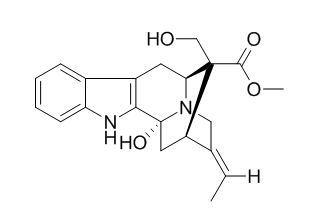16-Epivoacarpine
16-Epivoacarpine is a natural product from Gelsemium elegans.
Inquire / Order:
manager@chemfaces.com
Technical Inquiries:
service@chemfaces.com
Tel:
+86-27-84237783
Fax:
+86-27-84254680
Address:
1 Building, No. 83, CheCheng Rd., Wuhan Economic and Technological Development Zone, Wuhan, Hubei 430056, PRC
Providing storage is as stated on the product vial and the vial is kept tightly sealed, the product can be stored for up to
24 months(2-8C).
Wherever possible, you should prepare and use solutions on the same day. However, if you need to make up stock solutions in advance, we recommend that you store the solution as aliquots in tightly sealed vials at -20C. Generally, these will be useable for up to two weeks. Before use, and prior to opening the vial we recommend that you allow your product to equilibrate to room temperature for at least 1 hour.
Need more advice on solubility, usage and handling? Please email to: service@chemfaces.com
The packaging of the product may have turned upside down during transportation, resulting in the natural compounds adhering to the neck or cap of the vial. take the vial out of its packaging and gently shake to let the compounds fall to the bottom of the vial. for liquid products, centrifuge at 200-500 RPM to gather the liquid at the bottom of the vial. try to avoid loss or contamination during handling.
Biol Pharm Bull.2018, 41(1):65-72
J Microbiol Biotechnol.2022, 32(2):141-148.
Food Addit Contam Part A.2021, 38(12):1985-1994.
Asian Pac J Cancer Prev.2019, 20(1):65-72
Front Chem.2022, 10:1048467.
Tissue Cell.2024, 88:102401.
J Microbiol Immunol Infect.2021, S1684-1182(21)00142-0.
Molecular & Cellular Toxicology 2024, 00444-8.
Sci Rep.2018, 8:15059
Arch Toxicol.2017, 91(10):3225-3245
Related and Featured Products
Studies in Natural Products Chemistry, 1995 , 15 (06) :465-518.
Recent advances in the chemistry of Gelsemium alkaloids.[Reference:
WebLink]
This chapter reviews the recent intensive research that led to significant progress in the field of Gelsemium alkaloid chemistry. It presents alkaloids isolated from the Gelsemium species.
METHODS AND RESULTS:
The structure elucidation of the representative alkaloids using mainly spectroscopic methods is described. The chapter discusses the biogenetic speculation of the structurally unique Gelsemium alkaloids and the biomimetic transformation of the known indole alkaloids leading to the various skeletal types of Gelsemium alkaloids. A genuine indole nucleus is present only in the sarpagine group and sempervirine among the many skeletal classes of the Gelsemium alkaloids. The sarpagine group found in the Gelsemium species consists of six indole alkaloids, 19( Z )-akuammidine (koumicine), koumicine N -oxide, koumidine, 16-Epivoacarpine, 19(Z)-anhydrovobasine-diol, and N a -methoxy-19( Z )-anhydrovobasinediol.
CONCLUSIONS:
The structure elucidation of the indole alkaloid, the so-called akuammidine isolated from Gelsemium elegans is discussed in the chapter. The configuration of the ethylidene side chain was considered the 19( E ) form as generally found in the monoterpenoid indole alkaloids. The so-called akuammidine from G. elegans showed the same mass spectral fragment pattern as authentic akuammidine obtained from other plant sources.



